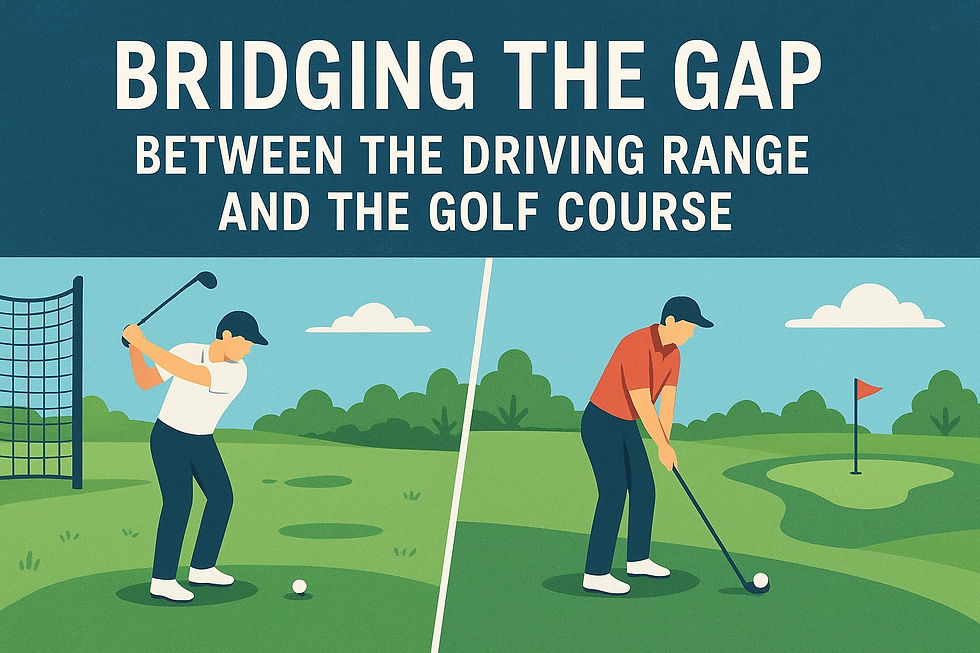Mastering Wedge Distance Control: The Game-Changer for Lower Scores
- Eric J. Mac Donald

- Jul 13
- 3 min read

If you want to lower your handicap fast, look no further than your wedges. I’ve seen it time and time again—players lose five to ten strokes per round due to poor distance control inside 100 yards. As a PGA Professional at The Old Course at Broken Sound, I coach my students through a structured system that blends tech, feel, drills, and accountability.
This post will give you a complete wedge distance control plan that combines data, purposeful practice, and on-course application.
Step 1: Benchmark Your Wedge Game
Before you can improve, you need to know where you stand. I use Decade, Stack Wedge, TrackMan Combine or Foresight GC Quad to collect baseline numbers from three wedge distances: 50, 75, and 100 yards.
Metrics we track:
Carry distance average
Standard deviation (consistency, think the shape pattern of all the shots combined)
Launch angle & spin
Proximity to target (offline left/right)
Student Example: One student’s average carry from 75 yards was 69 yards, with a 12-yard deviation. After three weeks of structured drills, his deviation dropped to 4 yards and proximity improved by 40%.
Step 2: Assign Feels to Stock Yardages
Instead of guessing, we map wedge yardages to specific feels and tempos:
50 yards = waist-high backswing, 50% tempo
75 yards = chest-high backswing, 70% tempo
100 yards = full swing at 85% effort
We calibrate these with real-time ball data using TrackMan or GC Quad and create a personalized chart.
I have students build a "Wedge Matrix"—a table of distances tied to feel, club, and spin profile. This eliminates guesswork.
Step 3: Apply Drills That Build Feel & Feedback
Drill #1: Ladder Drill (Carry Control)
Set cones at 10-yard intervals from 40 to 100 yards.
Start at the closest target and work up the ladder.
Only advance when your carry distance is within 3 yards of the cone.
Drill #2: One-Bounce Check Drill (Spin Feedback)
Hit 10 wedge shots with a premium ball.
Track how many land and stop within one bounce and roll.
Adjust clubface, ball position, or attack angle based on feedback.
Drill #3: Pressure Pyramid
3 shots at 50, 75, and 100 yards.
Must hit 2 out of 3 in target zone (within 15 feet).
If you miss, start over from 50.
Step 4: Bring It to the Course
Range drills are useful—but scoring happens on the course. I challenge my students to track wedge opportunities and outcomes during actual rounds:
From 100 yards and in, how many greens do you hit?
What’s your average first putt distance?
How often are you short vs long?
We log these stats in a Google Sheet and compare them week over week. I often ask players to film a few shots with their phone during rounds to review tempo and decision-making.
Step 5: Accountability & Video Feedback
I provide follow-up, where I can break down swings from both practice and the course.
Sample Feedback Clip: "At 75 yards, your backswing is too long, which is creating inconsistent launch windows. Let’s shorten it and pair it with a steeper angle of attack."
Using an app like Noonan we can overlay your short patterns of improved decision making.
This helps players stay focused on improving decision-making and their distance window.
Conclusion: Dominate the Scoring Zone
Wedges are the fastest way to shave strokes. By blending feel with feedback, tech with tempo, and drills with data, you can master wedge control and transform your scoring potential.
If you're ready to build your wedge matrix, design a custom practice plan, and start seeing real results, let’s work together—online or in person in Boca Raton.
🎯 Book a wedge session at www.ericjmacdonaldpga.com and take control of your scoring game.
Eric Mac Donald, PGA | TrackMan Certified | Foresight Certified | TPI Power 2 | SAM PuttLab Level 3 | GolfForever Coach













.jpg)



Comments